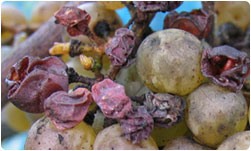|
|
| Trockenbeerenauslese Wines (TBA) |
| |
 |
The fifth category and next highest and rarest wine predicate is "Trockenbeerenauslese".
The term Trockenbeerenauslese means "dried berry selection", which is one step beyond Beerenauslese and the noblest of German wines. Trocken means "dry". In the best years, the grapes are overtaken by botrytis (so-called "noble rot"), the water in grapes evaporates and grapes shrivel up like raisins. It can take a single individual an entire day |
to individually select grapes to pick enough ones to make one bottle. Only those grapes over-ripe, botrytis-affected, and shrivelled dry will be selected.
German TBAs display an overwhelming intensity and complexity of flavors. They have the potential to age for up to 80 years and only get better with age. They are the King of German dessert wines.
These are extreme rarities, harvested only when very exceptional weather conditions enable the grapes to ripen to this extent. This kind of weather condition only appears around 2 times every 10 years at Mosel region in Germany.
Exceptional Weather Conditions for Trockenbeerenauslese (TBA)
The Botrytis spores are present in the vineyard throughout the entire year but remain dormant until the proper weather conditions prevail; a combination of cool temperatures and high humidity. Meanwhile, in order to gain the maximum advantage from botrytis, grapes must be left on the vines quite late in the season.
Then, with the combination of cool morning mist and hot, clear afternoon sunshine, the fungi can enter the grape.
Humidity can come from rain or fog. A common scenario is for morning fog from a nearby body of water to settle on the grape surface initiating an infection. Since Botrytis is a cool weather fungus, the temperature shall remain in the narrow range which permits a clean Botrytis infection unaccompanied by other molds. The fungi perforate the skin of the berries leaving the pulp open to the air.
If the grapes are perfectly healthy the "attack" is entirely beneficial. The grapes shrivel, first turning grey and then warm violet-brown. The skins are reduced to a mere pulp, the grapes lose more than half of their weight but less than half of their sugar. The juice is thus concentrated, extremely sweet and rich with glycerine.
Extremely hot weather more than 32 centigrade will dry up the infection altogether and cause raisining. Under ideal conditions, the afternoon sun dries up the moisture halting the growth of Botrytis and causing desiccation as water evaporates from the grape pulp, now exposed to the air.
Continued wet weather or high humidity following the initial Botrytis infection results in a mixed bag of fungal infections without the simultaneous dehydration of the fruit.
For TBA, this cycle of morning fog and afternoon sun shall even continue longer than that of Beerenauslese (BA). The cycle needs to last for about one month, and the grapes become very dry and shrivel into what resemble raisins. If temperature and humidity continue to be favorable, further noble rot occurs and successive harvests are made.
There is one critical issue is that not only must this specific weather conditions prevail to allow fungi the Botrytis to grow in the grapes, they must do so at the right time of the season when the grapes are at normal maturity of 22-25% sugar. Therefore the occurrence of such exceptional weather conditions is very much rare.
| German Beerenauslese (BA) and Trockenbeerenauslese (TBA) wines are the richest and rarest of all. Made in exceptional vintages, BA and TBA wines have a sweet, honeyed flavor. Vintners in Germany pick grapes throughout the fall, gambling with the weather for the ripest grapes before the cold weather hits. |
|
|
|
|

